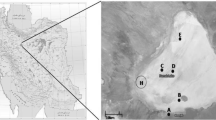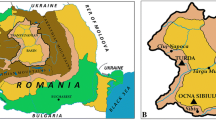Abstract
The Dagong Brine Well, the earliest man-made brine well in record, located in Zigong, Sichuan, China, had the construction and facilities mainly made of bamboo, wood and stone that are eroded easily by halophiles colonizing in the brine of the well. To better preserve this historic placemark, we initiated an investigation on the microbial community and the diversity of the halophilic bacteria in the brine of Dagong well for the first time. A total of 112 aerobic halophile strains were isolated and characterized according to their phenotype, cellular fatty acids composition and 16S rRNA. Furthermore, the intra specific phylogeny of closely related strains was also screened by PCR fragment length polymorphism of 16S–23S ribosomal RNA intergenic spacer regions (ISR). The result showed that the halophilic isolates found in current study were closely related to the following genera: Planococcus, Halomonas, Halobacillus, Oceanobacillus and Virgibacillus, a lineage of the domain Bacteria. Halomonas and Halobacillus were the dominant genera as represents 27% and 40% of the total isolates, respectively. The distribution of other genera was as follows: Oceanobacillus (18%), Virgibacillus (10%) and Planococcus (5%). The ISR analysis disclosed variation of banding pattern in some isolates related to Oceanobacillus and Halobacillus which was observed with phenotypic and physiological characterizations as well. It was clear that these halophiles have adapted to the special man-made hypersaline environment by the basic physiological evolution during phylogenesis and thus resulted in phenotypic and genotypic diversity in the Dagong Brine Well.


Similar content being viewed by others
References
Abd-El-Haleem D, Layton AC, Sayler GS (2002) Long PCR amplified rDNA for PCR-RFLP and Rep-PCR-based approaches to recognize closely related microbial species. J Microbiol Methods 49:315–319
Ashrafaddin S, Aliasghar K, Rastgar J (2005) Identification and characterization of salt-inducible polypeptide in Paenibacillus spp., a moderately halophilic bacterium. J Biosci Bioeng 100:573–575
Atlas RM (1997) Handbook of microbiological media, 2nd edn. CRC, Boca Raton, Florida, USA
Blaiotta G, Pepe O, Mauriello G et al (2002) 16S-23S rDNA intergenic spacer region polymorphism of Lactococcus garvieae, Lactococcus raffinolactis and Lactococcus lactis as revealed by PCR and nucleotide sequence analysis. Syst Appl Microbiol 25:520–527
Boyer SL, Valerie R, Flechtner et al (2001) Is the 16S–23S internal transcribed spacer regions a good tool for use in molecular systematics and population genetics? A case study in Cyanobacteri. Mol Biol Evol 18:1057–1069
Cytryn E, Rijn JV, Schramm A et al (2005) Identification of bacteria potentially responsible for oxic and anoxic sulfide oxidation in biofilters of a recirculating mariculture system. Appl Environ Microbiol 71:6134–6141
Dewhirst FE, Shen Z, Scimeca MS et al (2005) Discordant 16S and 23S rRNA gene phylogenies for the genus Helicobacter: implications for phylogenetic inference and systematics. J Bacteriol 187:6106–6118
Elevi R, Assa P, Birbir M et al (2004) Characterization of extremely halophilic Archaea isolated from the Ayvalik saltern, Turkey. World J Microbiol Biotechnol 20:719–725
Francisco RV (1986) The ecology and taxonomy of aerobic chemoorganotrophic halophilic eubacteria. FEMS Microbiol Lett 39:17–22
Garcya-Martynez J, Acinas SG, Anton AI et al (1999) Use of the 16S–23S ribosomal genes spacer region in studies of prokaryotic diversity. J Microbiol Methods 36:55–64
Gaylarde CC, Morton LHG (2002) Biodeterioration of mineral materials. In: Bitton G (eds) Encyclopedia of environmental microbiology, vol. 2, Wiley, NY, pp 516–527. ISBN 0471360473
Greicy K, Christine C, Gaylarde (2007) Diversity of salt-tolerant culturable aerobic microorganisms on historic buildings in Southern Brazil. Word J Microbiol Biotechnol 23:363–366
Griffiths RI, Whiteley AS, Donnell AGO et al (2000) Rapid method for coextraction of DNA and RNA from natural environments for analysis of ribosomal DNA- and rRNA-based microbial community composition. Appl Environ Microbiol 66:5488–5491
Gürtner C, Heyrman J, Lubitz W et al (2000) Comparative analyses of the bacterial diversity on two different biodeteriorated wall paintings by DGGE and 16S rDNA sequence analysis. Int Biodeterior Biodegradation 46:229–239
Gürtler V, Mayall BC (2001) Genomic approaches to typing taxonomy and evolution of bacterial isolates. Int J Syst Evol Microbiol 51:3–16
Gürtler V, Stanisich A (1996) New approaches to typing and identification of bacteria using the 16S–23S rDNA spacer region. Microbiol 142:3–16
Jensen MA, Webster JA, Straus N (1993) Rapid identification of bacteria on the basis of polymerase chain reaction amplified ribosomal DNA spacer polymorphisms. Appl Environ Microbiol 59:945–952
Kaye JZ, Carmen Marquez M, Ventosa A et al (2004) Halomonas neptunia sp. nov., Halomonas sulfidaeris sp. nov., Halomonas axialensis sp. nov. and Halomonas hydrothermalis sp. nov.: halophilic bacteria isolated from deep-sea hydrothermal-vent environments. Int J Syst Evol Microbiol 54:499–511
Kuhn O (2004) Salt drilling in ancient China and other Stories. J Can Soc Explor Geophys 6:39–43. http://www.cseg.ca/recorder
Kumar SK, Tamura I, Nei M et al (2004) MEGA3: integrated software for molecular evolutionary genetics analysis and sequence alignment. Brief Bioinform 5:150–163
Nagpal ML, Fox KF, Fox A (1998) Utility of 16S–23S rDNA spacer region methodology: how similar are interspace regions within a genome and between strains for closely related organisms. J Microbiol Methods 33:211–219
Nayak S, Prasanna R, Prasanna BM et al (2007) Analysing diversity among Indian isolates of Anabaena (Nostocales, Cyanophyta) using morphological, physiological and biochemical characters. World J Microbiol Biotechnol 23:1575–1584
Oren A, Litchfield CD (1999) A procedure for the enrichment and isolation of Halobacterium. FEMS Microbiol Lett 173:353–358
Oren A, Duker S, Ritter S (1996) The polar lipid composition of Walsby’s square bacterium. FEMS Microbiol Lett 138:135–140
Oren A, Ventosa A, Grant WD (1997) Proposed minimal standards for description of new taxa in the order Halobacteriales. Int J Syst Bacteriol 47:233–238
Oren A, Larimer F, Richardson P et al (2005) How to be moderately halophilic with broad salt tolerance: clues from genome of Chromohalobacter salexigens. Extremophiles 9:275–279
Ripka K, Denner EBM, Michaelsen A et al (2006) Molecular characterization of Halobacillus strains isolated from different medieval wall paintings and building materials in Austria. Int Biodeterior Biodegrad 58:124–132
Ruiz A, Poblet A, Mas JM, Guillamon (2000) Identification of acetic acid bacteria by RFLP of PCR-amplified 16S rDNA and 16S–23S rDNA intergenic spacer. Int J Syst Evol Microbiol 50:1981–1987
Shigematsu T, Tang YQ, Kawaguchi H et al (2003) Effect of dilution rate on structure of a mesophilic acetate-degrading methanogenic community during continuous cultivation. J Biosci Bioeng 96:547–558
Shirakawa MA, Gaylarde CC, Gaylarde PM et al (2002) Fungal colonization and succession on newly painted buildings and the effect of biocide. FEMS Microbiol Ecol 39:165–173
Singh S, Chandra R, Patel DK et al (2007) Isolation and characterization of novel Serratia marcescens (AY927692) for pentachlorophenol degradation from pulp and paper mill waste. Word J Microbiol Biotechnol 23:1747–1754
Smibert RM, Kreig NR (1994) Phenotypic characterization. In: Gerhardt P, Murray RGE, Wood WA et al (eds) Manual of methods for general microbiology. ASM, Washington DC, pp 607–654
Song Y, Liu C, Molitoris D et al (2002) Use of 16S–23S rRNA Spacer-Region (SR)-PCR for identification of intestinal Clostridia. Syst Appl Microbiol 25:528–535
Thompson JD, Gibson TJ, Plewniak F et al (1997) The Clustal X windows interface: flexible strategies for multiple sequence alignment aided by quality analysis tools. Nucleic Acids Res 24:4876–4882
Ventosa A, Nieto JJ, Oren A (1998) Biology of moderately halophilic aerobic bacteria. Microbiol Mol Biol Rev 62:504–544
Veys A, Callewaert W, Waelkens E et al (1989) Application of gas-liquid chromatography to the routine identification of nonfermenting Gram-negative bacteria in clinical specimens. J Clin Microbiol 27:1538–1542
Acknowledgements
This study was financially supported by the Salt Museum of Zigong, Sichuan, China.
Author information
Authors and Affiliations
Corresponding author
Rights and permissions
About this article
Cite this article
Xiang, W., Guo, J., Feng, W. et al. Community of extremely halophilic bacteria in historic Dagong Brine Well in southwestern China. World J Microbiol Biotechnol 24, 2297–2305 (2008). https://doi.org/10.1007/s11274-008-9744-0
Received:
Accepted:
Published:
Issue Date:
DOI: https://doi.org/10.1007/s11274-008-9744-0




